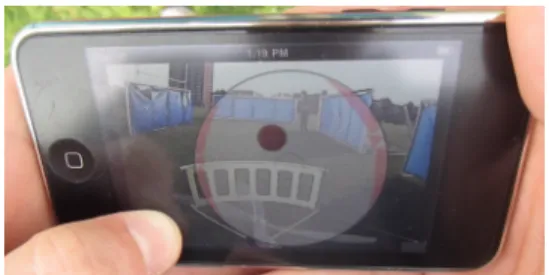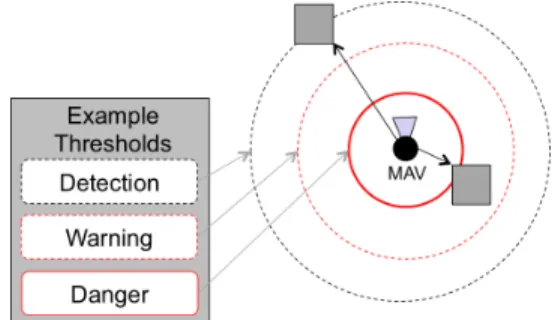Collision avoidance interface for safe piloting
of unmanned vehicles using a mobile device
The MIT Faculty has made this article openly available.
Please share
how this access benefits you. Your story matters.
Citation
Solovey, Erin, Kim Jackson, and Mary Cummings. “Collision
avoidance interface for safe piloting of unmanned vehicles using
a mobile device.” In Adjunct proceedings of the 25th annual ACM
symposium on User interface software and technology - UIST
Adjunct Proceedings 12, 77. Association for Computing Machinery,
2012. Copyright © 2012 ACM, Inc.
As Published
http://dx.doi.org/10.1145/2380296.2380330
Publisher
Association for Computing Machinery (ACM)
Version
Final published version
Citable link
http://hdl.handle.net/1721.1/81172
Terms of Use
Article is made available in accordance with the publisher's
policy and may be subject to US copyright law. Please refer to the
publisher's site for terms of use.
Collision Avoidance Interface for Safe Piloting of Unmanned
Vehicles using a Mobile Device
Erin Treacy Solovey
MIT
Cambridge, MA
erinsol@mit.edu
Kimberly Jackson
MIT
Cambridge, MA
kjackson@mit.edu
Mary L. Cummings
MIT
Cambridge, MA
missyc@mit.edu
ABSTRACTAutonomous robots and vehicles can perform tasks that are unsafe or undesirable for humans to do themselves, such as investigate safety in nuclear reactors or assess structural dam-age to a building or bridge after an earthquake. In addi-tion, improvements in autonomous modes of such vehicles are making it easier for minimally-trained individuals to oper-ate the vehicles. As the autonomous capabilities advance, the user’s role shifts from a direct teleoperator to a supervisory control role. Since the human operator is often better suited to make decisions in uncertain situations, it is important for the human operator to have awareness of the environment in which the vehicle is operating in order to prevent collisions and damage to the vehicle as well as the structures and peo-ple in the vicinity. In this paper, we present the Collision and Obstacle Detection and Alerting (CODA) display, a novel in-terface to enable safe piloting of a Micro Aerial Vehicle with a mobile device in real-world settings.
Author Keywords
Mobile; touchscreen; helicopters; UAV
ACM Classification Keywords
H.5.2. Information Interfaces and Presentation: User Inter-faces - Graphical user interInter-faces
General Terms
Design; Human Factors
INTRODUCTION
Recent advances in Unmanned Aerial Vehicles (UAV) and smaller Micro Aerial Vehicles (MAVs) have resulted in field use for a variety of military and civilian applications. Al-though the term MAV originally referred to a vehicle less than six inches in diameter, it can now refer to a broader range of small UAV systems. For these smaller, portable unmanned vehicle systems, the user interface technology has shifted to-ward small, portable handheld devices. By allowing the user to obtain immediate and current information about his or her surroundings, the systems are ideal for local observation and surveillance tasks, whether on the battlefield, in a disaster area, or for scientific observation.
While there is an increased interest in MAV systems recently, their widespread use will be limited unless a few key hur-dles are overcome. As MAV usage moves away from highly
Copyright is held by the author/owner(s).
UIST’12, October 7–10, 2012, Cambridge, Massachusetts, USA. ACM 978-1-4503-1582-1/12/10.
Figure 1. CODA display integrated in MAV-VUE interface, for use in navigating in an outdoor environment.
trained individuals in the military to everyday users in the real world, the user interface needs to have minimal training requirements. In addition, for these systems to successfully operate in crowded urban areas, unknown battlefield environ-ments, or constrained indoor spaces, they must have the abil-ity to cope with uncertainty and unexpected obstacles, espe-cially since most of these operations occur beyond the opera-tor’s line of sight. Thus, user interfaces that support collision avoidance are essential for effective operation.
The challenge is integrating this additional information about potential obstacles into the user’s display without affecting the usability of the interface or increasing the operator’s men-tal workload, or increasing the required training. For most systems, the small form factor and portability of a mobile dis-play provides a key advantage, but limits the disdis-play size and screen real estate. By presenting this information to operators in an intuitive, embedded way that does not increase mental workload, the system could improve the effectiveness of op-erators and lead to further adoption of UAVs and MAVs in a wider range of applications.
In this paper, we extend previous work on MAV user inter-faces by presenting techniques for supporting obstacle aware-ness and collision avoidance using visual and haptic mecha-nisms on a mobile device. We introduce the collision and obstacle detection and avoidance (CODA) system [1] which incorporates these techniques in a working MAV controller. With this work, we take steps towards making MAVs usable enough to operate safely, effectively, and consistently, and fa-cilitate wider adoption of MAV technology.
CODA USER INTERFACE
From observations during prior work and factors pertaining to the expected operating environment, the following require-ments for the collision notification system emerged:
• The display must warn the user of potential collisions in the vicinity, both within and outside the field of view. • The display must show information about location and
dis-tance of potential obstacles.
• The display must integrate effectively into an existing dis-play on a mobile device described below.
Existing mobile interface - MAV-VUE
The CODA interface extends the Micro Aerial Vehicle Vi-sualization of Unexplored Environments (MAV-VUE) inter-face, an iPhone-based application that could be used by a minimally-trained operator to accomplish local surveillance tasks. For a full description, the reader should refer to [2]. MAV-VUE’s nudge control mode allows for fine-tuned posi-tion inputs once the vehicle reaches an area of interest. This allows an operator to explore a unknown area out of his or her line-of-sight, relying on visual feedback from the device. The user gives flight controls through natural gesture inputs. To enable the controls, the user presses the ‘dead-man switch’, which is a type of fail-safe that requires constant active in-put to remain active and prevents unintentional control com-mands from affecting the system. While holding this switch, translational movement commands are given by tilting the de-vice in the desired direction of motion, with the degree of tilt corresponding to the magnitude of the input. Rotational com-mands require a one-fingered swiping motion around the cir-cle in the center of the display. Altitude commands involve a pinching motion, where the magnitude of the resulting com-mand is proportional to the size of the pinching input. In all three cases, the interface provides visual feedback in that the desired inputs have been received.
CODA design
The CODA interface consists of a combined visual and hap-tic alerting system to increase the operator’s awareness of po-tential hazards in the environment. The three alerting lev-els, shown in Figure 2, simplify the information presented to the operator. The visual indicators dual-code each level us-ing size and opacity, and a vibration accompanies the highest alert level for added saliency.
Two main factors contributed to the design: the anticipated environment and the capabilities of the hardware platform. The display must work in a variety of lighting and environ-mental conditions. A mobile device, or “smartphone” serves as the hardware platform for controlling the MAV due to its portability, functionality, and commercial availability. The screen is 2-inches by 3-inches, so screen real estate is lim-ited. The system has audio capabilities, and can play a num-ber of built-in alert tones along with an unlimited numnum-ber of sound files, but is volume-limited. The only haptic alerting mechanism consists of vibration feedback.
CODA Visual Display
For the design, it was assumed that the system would be equipped with one or more distance sensors that could pro-vide information about objects in a two-dimensional plane. Some distance sensors, like a laser rangefinder, can return many distance measurements every second, which may cause
Figure 2. Alerting structure with three thresholds, corresponding to dis-tance from the vehicle.
information overload if displayed to the user directly. To sim-plify the information presented to the operator, the alert sys-tem had three stages (Figure 2). Three distance-based thresh-olds are defined such that the alert increases in distinct steps, rather than gradually. Each indicator consists of a triangle and two arcs (Figure 1). The triangle precisely indicates the obstacle location, and the arcs increase in size and salience as the distance to the obstacle decreases, without obscuring the main control interface. Due to the limited screen size, the indicators were overlaid on the camera image instead of posi-tioned elsewhere, as that would require shrinking the camera display. The visual alert indicators were placed on the top of the navigation circle, rather than at the edge of the screen, which allowed them to be more central to the field of view. CODA Haptic Feedback
Based on pilot tests, haptic vibration feedback was incorpo-rated to increase the salience of the collision alert. The hap-tic alert is triggered when the user enters the highest alert threshold and occurs simultaneously with the appearance of the largest visual display indicator. The alert consists of a single vibration which occurs for a duration of approximately 1.5 seconds.
CONCLUSION AND FUTURE WORK
We presented the CODA interface, which provides useful in-formation about obstacles in the environment and warnings of potential collisions, without substantially increasing the re-quired training or mental workload. We have begun to deploy the system outside in a simple course with obstacles as a tech-nical demonstration that the platform functions as intended and can be further expanded to study collision and obstacle avoidance interfaces for MAVs. We then will be running ad-ditional studies both outdoors and in simulated indoor envi-ronments to test the user interface.
ACKNOWLEDGMENTS
We thank Kyle Moss for his contributions. This work was funded by Boeing Research and Technology.
REFERENCES
1. K. Jackson. Development and Evaluation of a Collision Avoidance System for Supervisory Control of a Micro Aerial Vehicle. Masters Thesis, MIT, 2012.
2. D. Pitman. Collaborative Micro Aerial Vehicle Exploration of Outdoor Environments. Masters Thesis, MIT, 2010.

